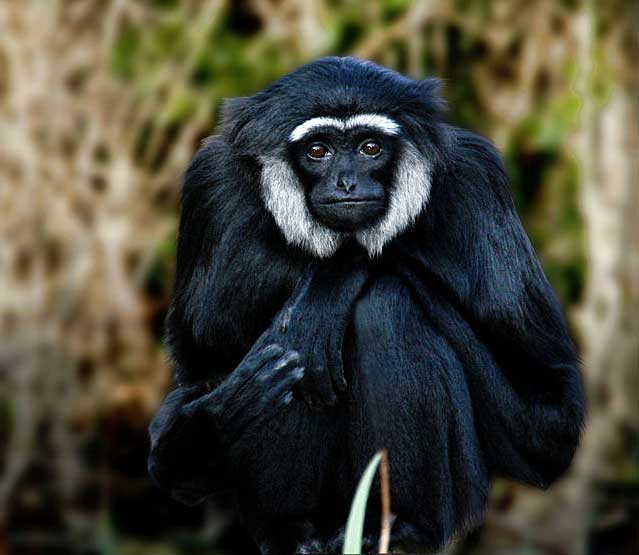
Hylobates agilis (*)
Superregnum: Eukaryota
Cladus: Unikonta
Cladus: Opisthokonta
Cladus: Holozoa
Regnum: Animalia
Subregnum: Eumetazoa
Cladus: Bilateria
Cladus: Nephrozoa
Superphylum: Deuterostomia
Phylum: Chordata
Subphylum: Vertebrata
Infraphylum: Gnathostomata
Megaclassis: Osteichthyes
Cladus: Sarcopterygii
Cladus: Rhipidistia
Cladus: Tetrapodomorpha
Cladus: Eotetrapodiformes
Cladus: Elpistostegalia
Superclassis: Tetrapoda
Cladus: Reptiliomorpha
Cladus: Amniota
Cladus: Synapsida
Cladus: Eupelycosauria
Cladus: Sphenacodontia
Cladus: Sphenacodontoidea
Cladus: Therapsida
Cladus: Theriodontia
Cladus: Cynodontia
Cladus: Eucynodontia
Cladus: Probainognathia
Cladus: Prozostrodontia
Cladus: Mammaliaformes
Classis: Mammalia
Subclassis: Trechnotheria
Infraclassis: Zatheria
Supercohors: Theria
Cohors: Eutheria
Infraclassis: Placentalia
Cladus: Boreoeutheria
Superordo: Euarchontoglires
Ordo: Primates
Subordo: Haplorhini
Infraordo: Simiiformes
Parvordo: Catarrhini
Superfamilia: Hominoidea
Familia: Hylobatidae
Genus: Hylobates
Species: Hylobates agilis
Subspecies dubiae: H. a. agilis – H. a. unko
Subspecies excludendae: H. a. albibarbis [=Hylobates albibarbis]
secundum Roos et al., 2014
Species: Hylobates agilis
monotypic taxon
Name
Hylobates agilis Cuvier, 1821 ["Le wouwou"]
Type locality: Indonesia, Sumatra.
References
Primary references
Geoffroy Saint-Hilaire, E. & Cuvier, F. 1818–1842. Histoire naturelle des mammifères, avec des figures originales, coloriées, dessinées d'après des animaux vivans. Paris. DOI: 10.5962/bhl.title.78766
Tome I & Tome II (livraisons); Tome III & Tome IV (livraisons); Tome V & Tome VI (livraisons); Tome VII (livraisons). Reference page.
Additional references
Roos, C., Boonratana, R., Supriatna, J., Fellowes, J.R., Groves, C.P., Nash, S.D., Rylands, A.B., & Mittermeier, R.A. 2014. An updated taxonomy and conservation status review of Asian primates. Asian Primates Journal 4(1): 2–38. PDF ResearchGate Reference page.
Thinh, V.N., Mootnick, A.R., Geissmann, T., Li, M., Ziegler, T., Agil, M., Moisson, P., Nadler, T., Walter, L. & Roos, C. 2010. Mitochondrial evidence for multiple radiations in the evolutionary history of small apes. BMC Evolutionary Biology 10: 74. DOI: 10.1186/1471-2148-10-74 Open access ResearchGate Reference page.
Hirai, H., Hayano, A., Tanaka, H., Mootnick, A.R., Wijayanto, H. & Perwitasari-Farajallah, D. 2009. Genetic differentiation of agile gibbons between Sumatra and Kalimantan in Indonesia. In Lappan, S. & Whittaker, D.J. (eds.) The gibbons: new perspectives on small ape socioecology and population biology. Developments in Primatology: Progress and Prospects 37. Springer: New York. ISBN 978-0-387-88604-6. DOI: 10.1007/978-0-387-88604-6_3 ResearchGate Reference page.
Links
Hylobates agilis in Mammal Species of the World.
Wilson, Don E. & Reeder, DeeAnn M. (Editors) 2005. Mammal Species of the World – A Taxonomic and Geographic Reference. Third edition. ISBN 0-8018-8221-4.
IUCN: Hylobates agilis Cuvier, 1821 (Endangered)
Vernacular names
català: Gibó àgil
Deutsch: Schwarzhandgibbon
English: Agile Gibbon or Black-handed Gibbon
español: Gibón ágil
français: Gibbon agile
עברית: גיבון גמיש
magyar: Fürge gibbon
Bahasa Indonesia: Ungko
日本語: アジルテナガザル
ქართული: შავხელა გიბონი
한국어: 검은손긴팔원숭이
ລາວ: ທະນີມືດຳ
Nederlands: Oenka
polski: gibon czarnoręki
پنجابی: کلہتھا گبن
русский: Чернорукий гиббон
српски / srpski: Црноруки гибон
svenska: Svarthandad gibbon
ไทย: ชะนีมือดำ
The agile gibbon (Hylobates agilis), also known as the black-handed gibbon, is an Old World primate in the gibbon family. It is found in Indonesia on the island of Sumatra, Malaysia, and southern Thailand. The species is listed as endangered on the IUCN Red List due to habitat destruction and the pet trade.
Taxonomy
The species is generally thought not to have subspecies, but some experts recognise a mountain form and a lowland form.[2]
Mountain agile gibbon, Hylobates agilis agilis
Lowland agile gibbon, Hylobates agilis unko
Description
The agile gibbon has fur varying in color from black to red-brown. The brow is white, and the male can be recognized by his white or light-grey cheeks. Additionally, the male is slightly larger than the female. The agile gibbon weighs from 4 to 6 kg (8.8 to 13.2 lb) with an average of 5 kg (11 lb), though in captivity it can reach 8 kg (18 lb).[4][5] It has a head and body length of 44–63.5 cm (17.3–25.0 in).[5] Like all gibbons it is tailless.
Behaviour
With its long arms they swing on branches, brachiating at a fast pace. Like all gibbons, it lives in monogamous pairs in a strictly enforced territory, which is defended with vigorous visual displays and songs.[4] The diet of the agile gibbon is generally frugivorous but have also been observed eating leaves, flowers, and insects.[4]
Females give birth to a single offspring after seven months' gestation. The young gibbon is weaned at barely 2 years of age. When fully mature, at about 8 years, it leaves its family group in order to look for a mate.[4]
Distribution and habitat
The agile gibbon is found on Sumatra southeast of Lake Toba and the Singkil River, in a small area on the Malay Peninsula, and south Thailand near the Malaysian border.[2] It predominantly lives arboreally in rain forests and rarely comes to the ground.
References
Groves, C. P. (2005). "Species Hylobates agilis". In Wilson, D. E.; Reeder, D. M. (eds.). Mammal Species of the World: A Taxonomic and Geographic Reference (3rd ed.). Baltimore: Johns Hopkins University Press. p. 179. ISBN 0-801-88221-4. OCLC 62265494.
Geissmann, T.; Nijman, V.; Boonratana, R.; Brockelman, W.; Roos, C.; Nowak, M.G. (2020). "Hylobates agilis". IUCN Red List of Threatened Species. 2020: e.T10543A17967655. doi:10.2305/IUCN.UK.2020-2.RLTS.T10543A17967655.en. Retrieved 19 November 2021.
"Appendices | CITES". cites.org. Retrieved 2022-01-14.
Kuester, J. (2000). "Hylobates agilis". Animal Diversity Web. Retrieved 6 January 2012.
"Fact sheet: agile gibbon" (PDF). EAZA Ape Campaign. 2010. Archived from the original (PDF) on 3 December 2013. Retrieved 6 January 2012.
Retrieved from "http://en.wikipedia.org/"
All text is available under the terms of the GNU Free Documentation License

